mobile View, to the German Version tap the flag
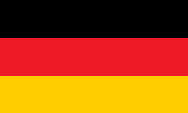

- Trentino-South Tyrol
- Autonomous Region of Italy,
consisting in:
- Province of Trentino
- Province of Bolzano (South Tyrol)
- own name: Trentino-Alto Adige
• Flag
• Meaning/Origin of the Flag
• Map of the regions of Italy
• Map of Trentino-South Tyrol
• Numbers and Facts
• History
• South Tyrol
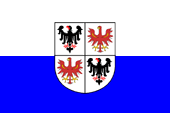
Flag of Trentino-South Tyrol,
ratio = 2:3,
Source, by: Wikipedia (D)






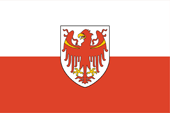
Official flag of South Tyrol (Alto-Adige),
Source, by: F l a n k e r / CC BY
via: Wikipedia (D)





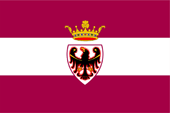
Official flag of the Trento Province,
Source, by: F l a n k e r / CC BY
via: Wikipedia (D)




The Flag of Trentino-Alto Adige shows two horizontal stripes in white and blue, and in the middle the coat of arms of the region. It is a quartered, silvery shield, which shows a black Eagle of Wenzel in the first and fourth field, the heraldry of the city of Trento, and in the second and third the red Eagle of Tyrol. The Eagle of Wenzel is a special heraldic symbol, namely an eagle darting tongue small flames from it. The origin of the colors of the flag is not cleared.
Source: Wikipedia (D),
Volker Preuß

all names in Italian
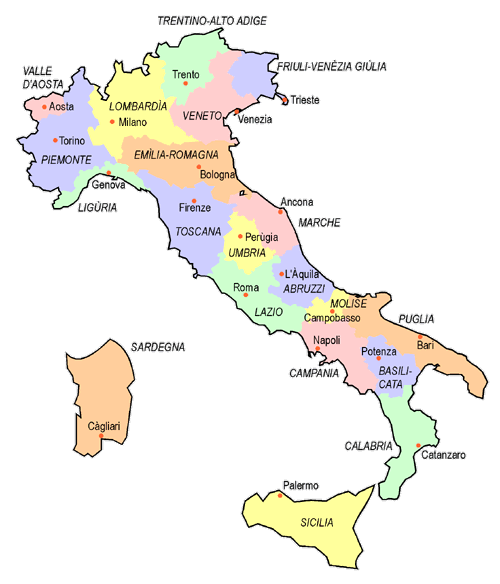
Source: Volker Preuß

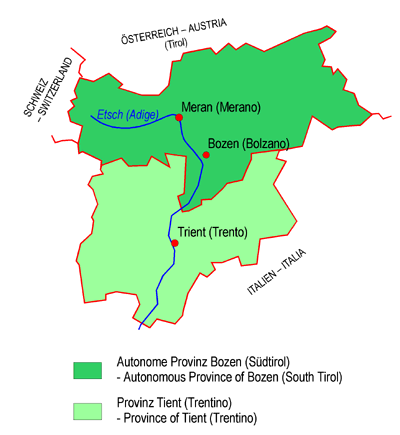
Source: Volker Preuß

Area: 5.254 square miles
Inhabitants: 1.074.800 (2019)
Density of Population: 205 inh./sq.mi.
Capital: Trient (ital.: Trento), 118.900 inh. (2019)
Languages: German, Italian
Time Zone: GMT + 1 h
Source: Wikipedia (D)

8000 B.C. · from Illyrians, Iberians and Ligurians as well as later immigrated Celts and Etruscians evolves the people of the Raetians
25 B.C. · Roman conquest, the Bolzano Area (South Tyrol) comes to the Province of Raetia, the Trento Area to the Province of Italia
476 · dismissal of the last Roman emperor Romulus Augustulus, end of the (West)Roman Empire, Trento-South Tyrol belongs until 493 to the Empire of the Odoaker
550–700 · invasions of Franks, Langobardes, Bajuwares and Slavs
8th cent. · Trento-South Tyrol comes to the Frankish Empire
843 · with the partition of the Frankish Empire comes Trento-South Tyrol to the Kingdom of Italy
961 · Otto I. brings Trento-South Tyrol to the German Kingdom
1363 · the House of Habsburg purchases Tyrol, and partially the control over the Diocese of Trento
1511 · the Diocese of Trento becomes an austrian protectorate
1803 · Trento gets connected with Austrian Tyrol
1805 · Bavaria purchases Tyrol
1810 · Tyrol gets partitioned between Bavaria (North Tyrol) and Napolèonic Italy (South Tyrol)
1815 · Vienna Congress, whole Tyrol (with Trento) becomes incorporated into Austria again
1919 · peace treaty of St. Germain, Austria has to cede South Tyrol and Trento to Italy, Trento-South Tyrol gets incorporated as Province of "Venetia Tridentina" into Italy
1948 · formation of the autonomous region "Trento Country - Upper Etsh Land" (Trentino-Alto Adige) consisting in the Province of Trento and the Province of Bolzano (South Tyrol)
1957 · autonomy statute for the Province of Bolzano (South Tyrol)
1992 · agreements between Austria and Italy confirm and corroborate the autonomy status of the region and the province Bolzano (South Tyrol)
Source: Atlas zur Geschichte,
Wikipedia (D)

- Province of Bolzano (South Tyrol)
- autonomous province within the Italian Region of Trentino-Alto Adige
- own names; German: Provinz Bozen (Südtirol), Italian: Provincia di Bolzano (Alto Adige)
• Flags
• Meaning/Origin of the Flag
• Coat of arms
• Meaning/Origin of the Coat of Arms
• Map of Trentino-South Tyrol
• Numbers and Facts

Official flag of South Tyrol,
Source, by: F l a n k e r / CC BY
via: Wikipedia (D)





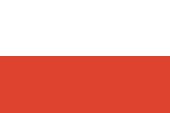
Flag of the country (Colours of the country),
ratio = 2:3,
Source, by: Wikipedia (D),
Färbung, nach: Dr. Peter Diem www.peter-diem.at



 up
up
 to South Tyrol
to South Tyrol
The Province of South Tyrol has the right, in the sense of the New Statute of Autonomy (Article 3), to keep its own coat of arms and its own flag. The coat of arms was approved in 1983, the flag gets the final approval by the Roman authorities not before the fall of the year 1996, and was approved by the South Tyrolean government (unanimous decision of 7th of October in 1996) on 21st of November in 1996 by decree of the President. In the middle of the flag is placed the coat of arms. The flag of Tyrol descents from the early 19. century and shows two stripes in white and red. It was introduced on 10th of March in 1949. The colours of the flag are derived from the colours of the coat of arms (red eagle on silvery ground). In the time of the monarchy, the country had – like all the other crown lands of the Austrian crown – its own colours (Landesfarben), which were used amongst others on horizontally two- or three-striped flags. The colours (Landesfarben) were very often taken from the respective coat of arms of the country or were supplemented by another colour, which not appears in the coat of arms, or they went back to older models of the coat of arms (e.g. Carniola). Officially, the colours had never been regulated or stipulated, so that their sequence varied in practice or even the colors deviated. The Austrian heraldist Hugo Gerard Ströhl (1851–1919) was probably the first to take care of it and asked for the colors (Landesfarben) on the flags at the respective state authorities around 1890 and compiled them. For Tyrol, white and red were ascertained as the country's colors of the crown land.
Source:
austria-forum.org,
Wikipedia (D),
Flaggen Enzyklopädie,
Flags of the World,
Volker Preuß,
Österreichisch-Ungarische Wappenrolle,
Mirko Costa, Bruneck, Südtirol
 up
up
 to South Tyrol
to South Tyrol

since 1983,
Coat of arms of the Province of Bolzano (South Tyrol),
Source, by: Helga von Aufschnaiter, by: F l a n k e r / Public domain
via: Wikipedia (D)
 up
up
 to South Tyrol
to South Tyrol
"The Tyrolean coat of arms shows a red eagle on a silver shield with a golden crown. The eagle looks to the heraldic right and is armed with golden claws and legs, golden bars in the wings ending in a shamrock and a green wreath, open on the top, behind its head."
Quote of Dr. Peter Diem on: Flags of the World
"The ancient coat of arms of Tyrol „red eagle on silvery (white) ground“ is handed down in colored depictions since 1271 resp. 1286. As the oldest reproduction counts the fresco in the chapel of Tyrol Castle in the times between 1271 and 1286.
A description – with details of the colours created about 1250 with the scutcheon-poem (Clipeus Teutonicorum) by the Canon Konrad on Mure – says: „Fert aquilam Tyrolis clipeus prestante rubore, que nigri pedis est alias albente colore“ (The white shield of Tyrol carrys an eagle of outsticking red colour and black feet). In difference was it since the 14th century usual to dye the catches and the arms of the eagle in gold. In the year 1416 the eagle got a crown and in 1567 a green wreath around its head."
Quote of: Mirko Costa, Bruneck, Südtirol
The Tyrolean eagle is used in various forms by different political bodies, such as the Austrian federal country of Tyrol, but also by the Autonomous Province of South Tyrol (Alto-Adige) and similarly in the Autonomous Province of Trento (Trentino, in German: Welschtirol). The two autonomous provinces of South Tyrol and Trento together form the Italian region of Trento-South Tyrol (Trentino-Alto-Adige).
In principle, the eagle is always the same, only inspired by historical models, as the coat of arms looked at specific times in a specific century, or an artist redesigned the coat of arms. In this way the today's coat of arms of the federal country of Tyrol was created in 1946. The eagle bears the crown awarded in 1416 and the coat of arms shows the green wreath, which was added in 1567. The green wreath was practically revived, because in the past times it was not shown. For South Tyrol, the template is the coat of arms of the Counts of Tyrol, executed like on the right wing outside of the altar of Castle Tyrol from 1370, with golden wing clips. It was redesigned in 1982 by the artist Helga von Aufschnaiter. In this form, the coat of arms was confirmed in 1983 by the Italian President. For Welschtirol (Province of Trento) the template is that coat of arms which Nikolaus Abrein, Prince-Bishop of Trento between 1338 and 1347, introduced in 1339. It is also an eagle, but black, with golden wing clips and shamrock ends, in a red flame wreath. Such an eagle model is called "Wenceslas Eagle", named after St. Wenceslas, a martyr and Bohemian prince from the ruling Přemyslid family from the first half of the 10th century.
Source: Wikipedia (D),
Flaggen Enzyklopädie,
Dr. Peter Diem on: Flags of the World,
Mirko Costa, Bruneck, Südtirol,
Volker Preuß,
Österreichisch-Ungarische Wappenrolle
 up
up
 to South Tyrol
to South Tyrol

Source: Volker Preuß
 up
up
 to South Tyrol
to South Tyrol
Area: 2.857 square miles
Inhabitants: 532.000 (2019)
Density of Population: 186 inh./sq.mi.
Capital: Bozen (ital.: Bolzano), 107.000 inh. (2019)
Languages: German, Italian
Time Zone: GMT + 1 h
Source: Wikipedia (D)
 up
up
 to South Tyrol
to South Tyrol

Kindly supported by:

![]()























